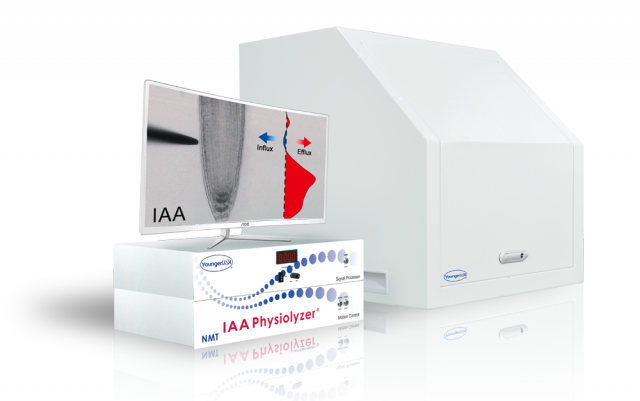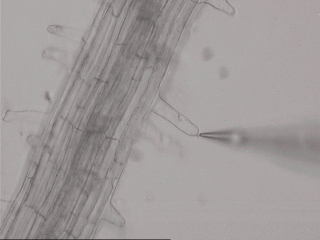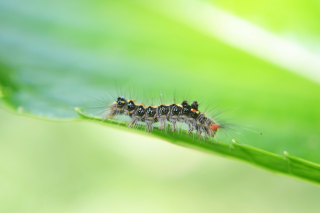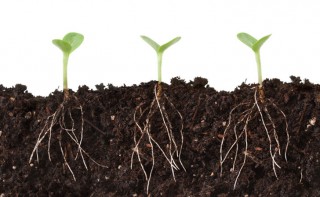Great news! We've just launched a new system in the NMT Physiolyzer® series: the IAA Physiolyzer®. This is the very first commercialized system in the world that can measure indole-3-acetic acid (IAA) flux in live samples, a feat which is sure to revolutionize research in areas such as development and signal transduction.
So what is IAA? It's a plant hormone in the auxin class, and is arguably the most well-known and well-researched of all auxins. In the early 2000s, Stefano Mancuso et al. developed the first microelectrode for in vivo IAA concentration detection. We (YoungerUSA) became the first to provide IAA flux testing commercially, and now we introduce the IAA Physiolyzer® as the first complete equipment system for detecting dynamic endogenous IAA flux from live intact samples.
You may wonder, what kind of research can be done with this system? It's especially useful for plant physiology applications like development and growth, and is perfect for detecting physiological reactions to genetic modifications, biotic and/or abiotic stimuli. To give a few examples, here are three great papers from labs using our NMT systems for IAA flux detection:
1. IAA signaling pathway for root hair growth
Root hairs have many essential roles for plants, such as nutrient and water absorption. Auxins such as IAA are known to be very important in the initiation and elongation of root hair growth, and researchers from Yangtze University investigated this process. They used trifoliate orange seedlings, which tend to produce very few root hairs, in order to evaluate the effects and mechanisms of auxins on root hair development. Our NMT system was used to detect the rate of endogenous IAA efflux, helping them to find a positive correlation between this efflux and the number of root hairs grown on the root.
Zhang D.J. et al. Auxin modulates root-hair growth through its signaling pathway in citrus. Scientia Horticulturae. 2018. 73-78
2. Insect herbivory of leaves affects IAA flux
In order to defend against insect attack, plants must redirect energy and slow down their rate of growth, a process involving phytohormones like auxin. Researchers from the Beijing Forestry University investigated this growth reduction by using our NMT system to measure endogenous auxin (IAA) flux in the roots immediately following an insect attack. Using whole Arabidopsis seedlings, they introduced larvae onto one leaf, allowed them to eat some, and then cleared them off. The seedlings were then immobilized in a dish so the roots could be measured by our NMT system with no additional damage. They measured IAA and H+ flux, and found significant flux differences between these eaten samples and the intact control samples. This helped them characterize auxin transport patterns and a mechanism for the plant growth reduction.
Yan S. et al. Insect Herbivory of Leaves Affects the Auxin Flux Along Root Apices in Arabidopsis thaliana. J Plant Growth Regul. 2017. 36: 846
3. IAA fluxes help reveal why roots grow away from light
When exposed to blue light, Arabidopsis roots grow away from the light source, a response called negative phototropism. But why does this happen? Researchers from the Chinese Academy of Sciences investigated the mechanism of this reaction using transgenic lines and IAA flux data. Since our NMT system allowed them to measure IAA flux in situ, they were able to identify the exact region of the root tip that showed the strongest IAA influx, and this region helped them compare the IAA flux between different mutants and light levels. The NMT IAA flux data helped them figure out a signaling pathway that contributes to the negative phototropic response.
Wan Y. et al. The Signal Transducer NPH3 Integrates the Phototropin1 Photosensor with PIN2-Based Polar Auxin Transport in Arabidopsis Root Phototropism. Plant Cell. 2012. 24(2):551-65.
These are just a few examples of how the IAA Physiolyzer® can reveal physiological functions through dynamic IAA flux measurements. Though these cases all study plants, the IAA Physiolyzer® can also measure IAA flux in many more samples like bacteria, mycorrhiza, and animal cells/tissue. No matter what you study, this one-of-a-kind system will surely make your research stand out.
Check out the full product page for the IAA Physiolyzer®.
Experience the NMT Physiolyzer® Our most advanced NMT system yet: This highly advanced instrument is allowing scientists to discover physiological functions of live samples in innovative new ways. With customizable software, you can choose from 12 ions and molecules for your own personalized system.
The Theory of NMT Check out the principles of how NMT works.





